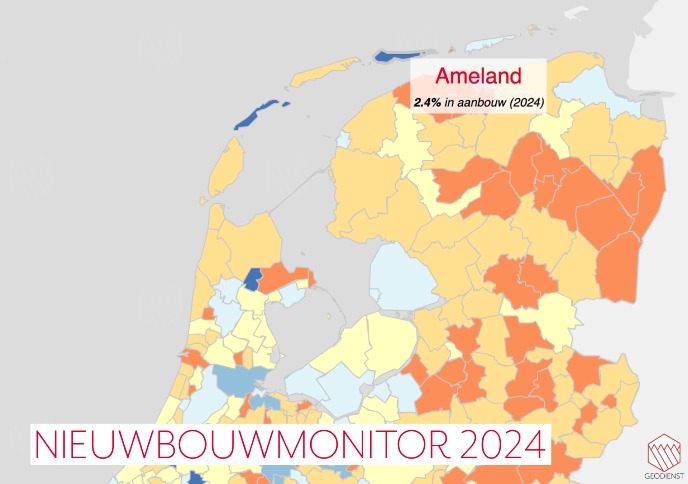Figures construction of new houses 2024 available in RUG Construction-monitor (‘Nieuwbouwmonitior’)

In recent years, the housing market in the Netherlands has been characterised by a shortage of suitable housing. To get a grip on the housing market, the central government has formulated the ambition in the Programma Woningbouw (‘Housing Construction Programme’) to expand the total amount of available housing by about 1 million new homes in the period 2021-2030, which amounts to an average of 100,000 new homes per year. The Geodienst's Construction-monitor puts these ambitions into perspective.
Since 2013, the Construction-monitor has been tracking new construction trends annually at national and municipal level. Recently, the most recent figures for 2024 were added to the Construction-monitor, meaning that more than ten years of (regional) data on new construction is now available. What do these figures show? And what expectations does this offer for the future? The Geodienst did an analysis based on the RUG Nieuwbouwmonitor.
Small increase in number of homes delivered
By 2024, 77,507 new homes will have been delivered. The number of new homes completed each year has increased sharply after bottoming out in 2014. However, this increase has been small in the last three years and the number remains around 70,000 new homes per year in 2024 as well. This falls far short of the central government's ambitions in the Housing Construction Programme to build one million new homes between 2021 and 2030 A positive sign from the New Construction Monitor is that the number of homes under construction is still rising every year and has probably not yet reached its peak. Construction is also increasing in scale so that larger volumes will eventually be delivered and the average construction duration has increased. In addition, in seventeen municipalities, the housing stock has actually shrunk. The question therefore remains how we are going to reach the number of one million new homes by 2030.
The Geodienst asked professor of public housing and property development Arno van der Vlist and Dr Niels Kuiper of urban economics and real estate for interpretation.
In recent years, the focus has mainly been on the supply side of new construction, such as development sites, planning procedures and construction costs. Current macroeconomic developments mean that more attention is being paid to the dynamics on the demand side for the development and sale of new-build homes. Rising interest rates and changing sentiment are causing demand for new-build homes to decline. In addition, new legislation such as the Affordable Rent Act (Wet betaalbare huur) affects new construction production. These issues may cause new construction volumes to decrease in the coming years. Especially for large-scale new construction, smart phasing will become increasingly important. This, together with the still existing frictions on the supply side, makes it unlikely that we will be able to catch up with the already existing backlog of plans in the Housing Programme in the coming years.
Construction of housing in Randstad lags, other regions do well
National trends disguise regional differences: The provinces outside the Randstad are doing well and, at the time of writing, are on track to meet the task from the Housing Construction Programme. In contrast, the Randstad provinces (North, South Holland, Utrecht and Flevoland) are behind schedule: after two years, 20% of the programme's time has passed and only 11% of the task has been realised. This is problematic as these provinces are responsible for 66% of new construction production. Differences are also visible within provinces.
Geodienst
The Geodienst is part of the Research domain of the Center for Information Technology (CIT) of the University of Groningen. The domain supports researchers at the university with high-quality ICT facilities and consultancy in the fields of Data Science, Visualisation, Geodienst and High Performance Computing.
| Last modified: | 14 June 2024 11.37 a.m. |
More news
-
10 June 2024
Swarming around a skyscraper
Every two weeks, UG Makers puts the spotlight on a researcher who has created something tangible, ranging from homemade measuring equipment for academic research to small or larger products that can change our daily lives. That is how UG...
-
21 May 2024
Results of 2024 University elections
The votes have been counted and the results of the University elections are in!
